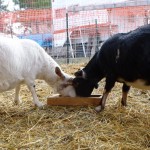by Catherine Haug, March 18. 2013
(photo, right, from Brenda Lee)
See also about Sheree’s Nigerian Dwarf Goats – Perfect for town lots.
This is the first in what I hope to be a series of articles on different breeds of goats raised in the Flathead.
Back in 2008, Gayle Prunhuber did a presentation on Keeping a Family Goat, at her home in Ferndale. Gayle keeps Toggenburgs, which are a “normal” size breed (30″ – 38″). Some of us were dismayed to learn how much land it takes to keep a couple goats: about 3/4 acre, penned. But that considers allowing them to browse, which is their natural feeding pattern.
Smaller breeds such as Nigerian Dwarf or Kinder Goats require less land, and/or if you feed them hay and alfalfa rather than browse,- it is actually doable on a city lot!
One caveat about city lots: Be sure to check your covenants and/or zoning regulations, to be sure goats are allowed.
See Kinder Goats, by Brenda Lee for a printable pdf version of the following article, and more photos.
Kinder Goats
by Brenda Lee
The Kinder goat was started in Snohomish Washington in the 1980’s. The Kinder breed was originally a cross between a Nubian doe and a Pygmy buck. What they found was nothing short of amazing! This medium sized goat is a dual purpose power house.
Standing 20″-26″ at the withers for does and up to 28″ for bucks, makes this breed easy to handle. They average 100-135 lbs as adults. Kinders are known for being very hardy – handling our Montana winters with ease.
Don’t forget the milk! Kinder goats have the highest butter fat of any goat. What we have found is with a gallon of Nubian milk – we got 12 ounces to 1 pound of cheese, but with our amazing Kinders – 1 gallon of milk usually gets us a return of 2-3 lbs of cheese. Mischief, as a second freshener averaged 5 quarts of milk a day. Those who can’t stand goat’s milk LOVE our Kinder milk! Kinders have earned their stars using the same ADGA requirements of their larger counterparts – matching them for milk production.
These dual purpose wonders provide plenty of meat as well. Dressing out at 50%-60% in some cases. Kinders are by far the best of both worlds and with all their great traits, make them the perfect homestead goat.
Because they are medium sized goats, they require less feed than other breeds. We feed quite a variety to our girls and boys, to give them optimal health! They receive 1 – 50 lb bag size of grain every two weeks for all 9 adult goats. We also provide good quality grass hay, and feed clean alfalfa twice daily. We also dehydrate garden odds and ends to feed them through our long winters. We provide kelp, dolomite lime, sodium bicarbonate, and nutritional yeast.
Kinders don’t need their hoofs trimmed as often as other breeds do. We trim hoofs every three months. We provide 20 sq. ft. of barn space per goat. The structure needs only to keep out the wind and rain/snow. Easy keepers indeed. But to maintain optimum health, we have tested our herd for CAE, CL, Bangs, and Johnes. We have a closed herd policy to protect our investment. To help them stay at their best, we provide alternate paddock areas for grazing.
One of the Pygmy traits that Kinders are known for is the fact that they can be bred any time of the year. Kinders are known to handle multiple births without assistance. They have also made records of having sextuplets’! Our Antares, a 4th generation Kinder buck is known to have quads and quints in his line. Multiple births are very common, even with first fresheners. Our Mischief gave us triplets as a first freshener.
Truth be told, if you want a dual purpose – easy keeper – then the Kinder is for you.
[See Kinder Goats, by Brenda Lee for a printable pdf version of the article, and more photos.]
